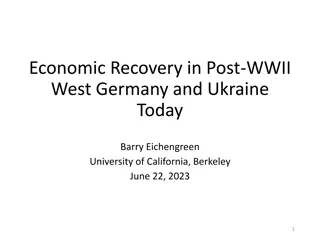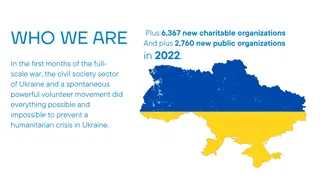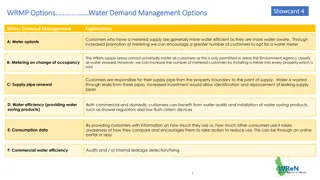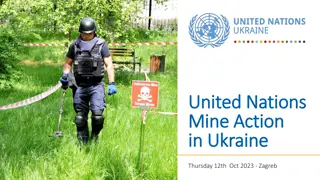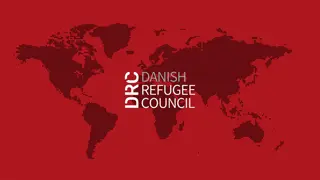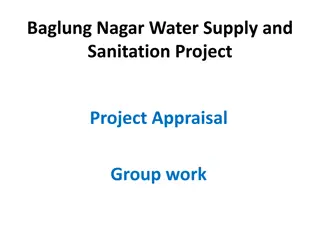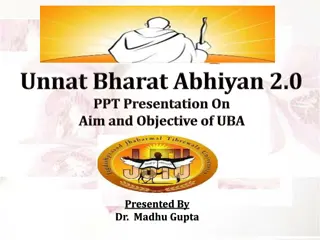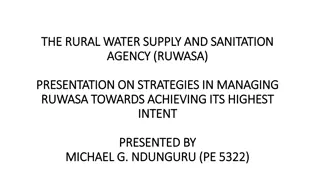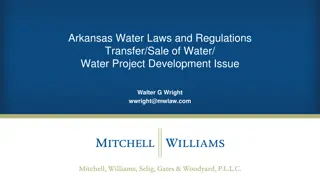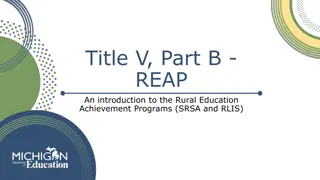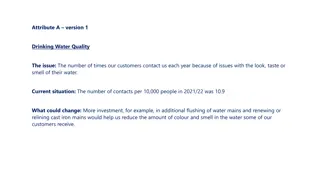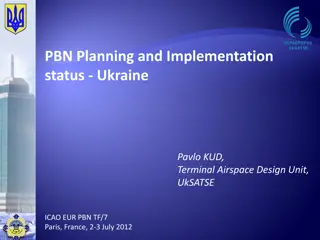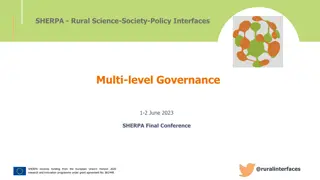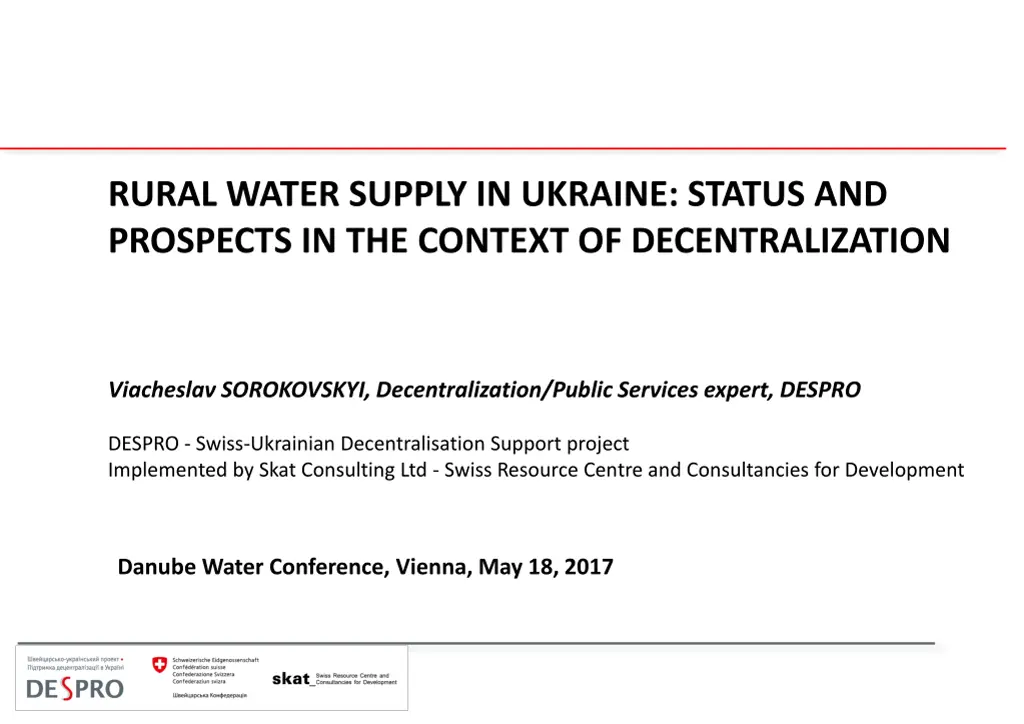
Decentralization Impact on Rural Water Supply in Ukraine
Learn about the current status and future prospects of rural water supply in Ukraine within the context of decentralization. Explore the challenges faced due to administrative fragmentation and the ongoing reform towards amalgamated communities. Discover the urban-biased state policies, implementation issues, and the low access to piped water supply in villages.
Download Presentation

Please find below an Image/Link to download the presentation.
The content on the website is provided AS IS for your information and personal use only. It may not be sold, licensed, or shared on other websites without obtaining consent from the author. If you encounter any issues during the download, it is possible that the publisher has removed the file from their server.
You are allowed to download the files provided on this website for personal or commercial use, subject to the condition that they are used lawfully. All files are the property of their respective owners.
The content on the website is provided AS IS for your information and personal use only. It may not be sold, licensed, or shared on other websites without obtaining consent from the author.
E N D
Presentation Transcript
RURAL WATER SUPPLY IN UKRAINE: STATUS AND PROSPECTS IN THE CONTEXT OF DECENTRALIZATION Viacheslav SOROKOVSKYI, Decentralization/Public Services expert, DESPRO DESPRO - Swiss-Ukrainian Decentralisation Support project Implemented by Skat Consulting Ltd - Swiss Resource Centre and Consultancies for Development Danube Water Conference, Vienna, May 18, 2017
UKRAINE: Rural water service provision is shaped by administrative fragmentation, now under amalgamation Unitary state Population - about 42,5 million, excl. ARC (State Statistics, (1/3/2017) One third of population lives in rural areas GDI per capita 2640 US$ (WB, 2017) 4 tiers public administration Local Self Governance set-up: 1. National level 2. Regions - 27 3. Sub-regional - 490 rayons 4. Local: Cities 460 Small cities/towns - 885 Village councils 11 000 ONGOING REFORM: Amalgamated communities (hromadas) 419 (10/05/2017)
UKRAINE: State policies, implementation and monitoring in water supply urban-biased (urban utilities) Principles set in the law No special focus on rural water supply Much about rules and regulations (e.g. service performance, tariff setting, licensing ) Less about support functions Policy formulation State Program Drinking Water : 2006-2011 urban water supply only 2012 incl. rural water supply 2013 onwards - did not receive financing National report since 2010 is not published annually; issues with data quality and lack of data for services in rural areas Implementation and financing Monitoring and evaluation
UKRAINE: less than 1 in 5 people in villages have access to piped water supply Coverage with piped water supply in settlements 98% 100% 90% 90% 89% 80% 70% 15 mln 69% 60% 50% 5 mln 40% 2 mln 30% MDG target 30% 23% 20% 10% 17% 0% 2001 2002 2003 2004 2005 2006 2007 2008 2009 2010 2011 2012 2013 2014 2015 cities towns villages Sources: State Statistics Service (2003-2014) National Report on Drinking Water Quality and Drinking Water Supply (2015) X State programme Drinking water of Ukraine financing
And what is happening at local level? VIDEO https://www.youtube.com/watch?v=FoDdwsac2H0
Scaling-up of local government led projects i) access to information and know-how building ii) availability of seed grants and iii) clearer national and regional policies
PUBLICLY OWNED PUBLICLY MANAGED: How to raise the bar for municipal enterprise performance Municipal (communal) enterprises : A new trend for rural areas starting with amalgamates municipalities Typical areas for improvement of water utilities in small towns*: Introducing strategic planning (instead of available resource- based planning ) Proper asset management Overcoming HR-related problems (staff qualification, incentives) Modern practices for accounting and financial management Source: DESPRO data, based on experience in 5 partner small towns in 4 regions of Ukraine: Sumy, Dnipropetrovsk, Poltava, and Ivano-Frankivsk (2014-2016)
A KEY QUESTION FOR THE STATE TO ADDRESS URBAN-RURAL SERVICES GAP: Shall and can DECENTRALISATION bring a new paradigm to complement existing state policies in water supply?
PUBLICLY OWNED PUBLICLY MANAGED: landscape of practices 2993 utilities - water supply (and sewerage) service providers (2015*): 1605 (54%) communal 64 (3 %) - state other 43% systems managed by public institutions (e.g. schools, hospitals, military base, etc.) Licensed business activity: National regulator: >30,000 people served and >30,000 m3/year Regional authorities other licensed providers Tariff approval: National regulator for nationally licensed utilities Local self-government for others Sources: * National report on Drinking Water Quality and Drinking Water Supply for 2015 (Minregion, 2016)


